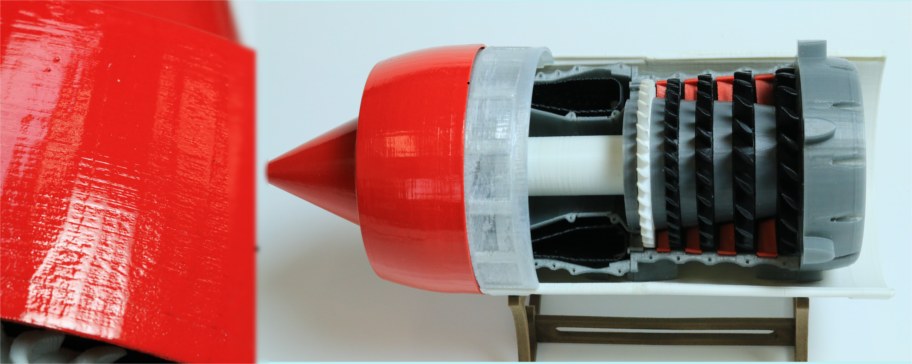
PLA is a biodegradable thermoplastic (fusible plastic) which is produced from corn or cornflour.
The material has a high Hardness and stiffness and is even more brittle than for example ABS..
PLA is resistant to most chemicals and can be almost free Print distortion.
We recommend PLA always when it comes to very large, expensive parts such as housing.
Contrary to popular belief, PLA decomposes only insignificant faster than "normal" plastics, even when used outdoors.
The biodegradability takes place (eg in a compost heap) only under controlled conditions.
Advantages
Disadvantages
PLA is usually used to make larger components such as the casing.
The quality of the printing available in ABS or other FDM materials.
PLA prints very dimensionally stable due to the low shrinkage and low distortion.
PLA is produced in the so-called FDM procedure.
FDM is spelled out "Fused deposition modeling".
FDM is one of the simpler procedures of 3D printing. Manufactured components have
layers (coatings) on. The advantage of this technology is the
pressure in a high variation of materials and the direct use of technical
Plastics. The material is genuinely applied and thus differs
to most other procedures, with materials with approximate work properties
. Another advantage is the possibility of closed cavities.
FDM is not appropriate for small parts, as these overheat.
The procedure:
The model is broken down into layers of 0.1 0.2 mm.
Now, a plastic wire is pressed through a heating nozzle and a viscous
State puts. A CNC-controlled print head now moves from the contour of the component
and thereby contributes to the desired thickness.
Washable support structures from alcohol prevent a hang from overhangs.

Shipping within
8 Working days
Minimum wall thickness
1 mm
Smallest Detail
0.3 mm
Maximum dimension
ø 170 mm x 285 mm
When ordering before 12 noon we ship within 2 working days. �
Price
30 % extra charge
The surface of your model is determined by the technology and the chosen material. Therefore, we offer several post-processing steps. This affects the cost, but also the quality of your model.
The natural surface of the PLA is perfect if you want your model just as functional or demonstration prototype. So you will see the material and procedures based on the surface, since we do anything other than to print your part to remove the insulators and to ship it to you.
Available colors:
Black, White , Half transparent, Green, Grey , Blue , Orange , Red, Yellow , Pink, Brown, Gold
" Polished"models in PLA have no high-gloss finish. They have a slightly rough but very smooth surface.
All parts are sanded by hand and then sandblasted. For this reason, it may be that your part is subsequently rejected if it is not to edit by hand.
What is to be observed on polished models:

Of course, 3D models made of PLA can also be painted .
Here, the quality and RAL color can be selected. The basic version of the painting is a simple "spray paint"..
This means that is your part lightly sanded and then painted. Construction stages and the similar are still easily recognizable..
The highest quality is the quality in premium (car paint). This "Polishing" must be booked with. This "Polishing" must be booked with.
Your part is sanded, polished, filled, wet sanded and painted.

PLA Parts can be wonderfully coated also.
To do this, your model is sanded and then coated with your desired equipment. Here also a coating with as gold or silver is possible.
| Copper | 99,99% Cu | IMDS Nr. 736943 |
| Matt nickel, from Sulfamatelektrolyt | 99,95% Ni | IMDS Nr. 748706 |
| High-gloss nickel | >99,50% Ni | IMDS Nr. 749088 |
| Gold plating 24ct. | 24 Karrat Au | IMDS Nr. 756617 |
| Silver plating | 99,99% Ag | IMDS Nr. 757803 |
| Chrome plating | from the trivalent electrolyte, RoHS Compliant | IMDS Nr. 756617 |
| Black chrome plating | electrically conductive, Black Chrome coating | IMDS Nr. 10629626/1 |
| Electroless Nickel Plating | hochphosphorig, 13% Phosphor as NiP | IMDS Nr. 326271538 |
| Tin plating | 99.98% Sn, RoHS-Konform | |
| Bismut | our Bismudan� electrolyte, 99,95% Bi |
| Unit | Value | ||
|---|---|---|---|
| Tensile strength | MPa | 110,24 | |
| Elongation at break | % | 15-30 | |
| Hardness | HRC | n/a | |
| Thermal resistance | �C | 50 | |
| Impact resistance | kJ/m� | 13,5 | |
| Density | g/cm� | 1,3 | |
| Water absorption | % | 0 | |
| Chemical resistance | Heavily Resistant to chemicals | ||
| Weather | Not resistant | ||